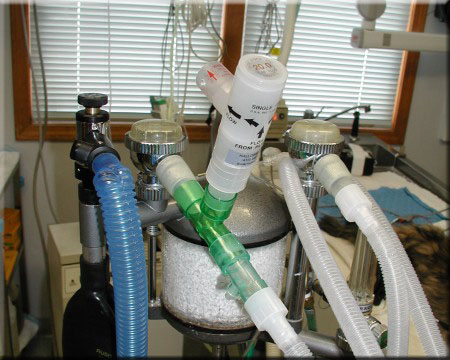 |
Veterinary Anesthesia & Analgesia Support Group |
| Practical Information for the Compassionate Veterinary Practitioner |
|
| HOME |
|
 |
||
|
|
|||
| Bob Stein | |||
| Updated February 2018 | |||
Pop-off valve related morbidity and mortality is an often discussed adverse anesthetic outcome. Left closed, excessive pressure build in the anesthetic system. In the short term the patient is unable to ventilate which increases PaCO2 and decrease PaO2. As pressure builds, pulmonary barotrauma develops; in the extreme, lungs rupture and collapse as pneumothorax develops. Hypoxic brain damage, including blindness, can result. Pneumothorax requires chest aspiration and possible chest tube placement. Pyothorax could develop. The cost of extended hospitalization and the mental anguish associated the patient's disease and potential death is incalculable. What are the problems associated with pop-off valve use:
The best solution that addresses almost all primary care setting pop-off valve related accidents is the pop-off occlusion valve. This simple device addresses the issue outlined in the 1st and 3rd points above; these add-ons make it simple to provide intermittent positive pressure ventilation. Pop-off occlusion valves should avoid most pop-off valve closure related accidents but there is a catch:
If we are faced with the reality that pop-off valve will occasionally be left closed how can we avoid the most serious patient injury?
The problem with the first option is that many practices will simply not devote the time it takes to tinker with cuff volume to achieve the precise ability to provide PPV at 15 to 20 cmH2O while system pressures above 20 cmH2O are allowed to bypass the cuff and escape the system. The problem with the reverse PEEP option isn't cost or complexity. Quite simply, few practitioners know about this option and even fewer know where to get the parts needed to add this feature to their systems. Now, there are two inescapable truths:
But are these two elements enough by themselves? Many would think so. They should read this email sent to me by a veterinary student relating a serious adverse event that befell her dog while under the care of the anesthesia and surgical services at a major US veterinary teaching hospital. If you goal is to avoid all pop-off valve related adverse events possible, you need to commit to three basic elements:
|
|||
 |
 |
||
| Pop-off Occlusion Valves | Reverse PEEP Valves | ||
| Bob Stein | |||
| Updated December 2019 | |||
| Questions or problems regarding this web site should be directed to DRSTEIN@VASG.ORG . Copyright © 2003 ASAH. All rights reserved. Last modified: January 2, 2024 . |
|||